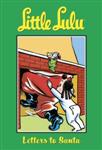
There was an odd comics book ad that stuck in my head as a young comics geek in the 1970s. I still remember three things about the ad: it was a sweepstakes sponsored bythe Clark candy company; it had a big picture of a bunch of Marvel superheroes in the middle; and it promised the chance to meet anyMarvel or DC superhero… or “even Little Lulu.” As a comics reader in the 1970s, I had no idea what Little Lulu was, but I knew it didn’t sound as cool as Spider-Man, so I ignored it. What a pity: had I done a little exploring, I might have been exposed to a piece of graphic brilliance.
Little Lulu stands alongside the Carl Barks Donald Duck stories for sheer comic genius told through simple formulas. Where Barks’s drawings were highly detailed and every episode featured a different, highly imagined setting for his cast to explore, Little Lulu, in the hands of writer/layout artist John Stanley and finish artist Irving Tripp, had simple, clean drawings, and only about four storylines: Lulu would get revenge on the boys for something; her friend Tubby would investigate a “crime,” usually perpetrated by Lulu’s dad; Lulu would tell the little neighborhood brat Alvin a story in which a girl would triumph over all odds; and “wild card” stories where Lulu might get into some unspecified trouble with her friends. Within those limits, the comic was brilliant. Lulu serenely sailed above all troubles, got the best of all the boys, and gleefully dealt vengeance on the neighborhood boys. And the art, simple though it is, is a touchstone alongside 50s era Peanuts and Ernie Bushmiller’s Nancy for clean, stylized grace.
Now, thanks to Dark Horse, the original Little Lulu comics are being reprinted in chronological order. (Again, Little Lulu seems like the odd man out in a line-up for me, since Dark Horse is known primarily for gritty indie titles like Concrete, Sin City, and Hellboy, as well as for licensed comics like the massively popular Alien vs. Predator and the Star Wars titles.) The Little Lulu series is now up to Volume 6, and all the elements are in place. All the classic story tropes are in evidence here, with Lulu ad Tubby creating chaos for a truant officer, a ghost, a customer at the butcher shop, and of course Lulu’s long suffering parents.
But the best and probably most poignant story in the collection is the title story (which bears no title in the collection itself), featuring Lulu asking for a new doll so she can give her beloved old doll to the poor girl down the street. It’s an old story, but effectively told here, and a nice counterpoint to the commercialism ofthe season.
One minor quibble: as with Dark Horse’s other Little Lulu compilations, all the art is black and white, which detracts a little from the charm of the drawings; otherwise the collection is impeccably done, and will be enjoyed by fans of classic comics and young new readers alike.
This post originally appeared on Blogcritics.


